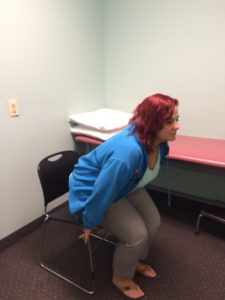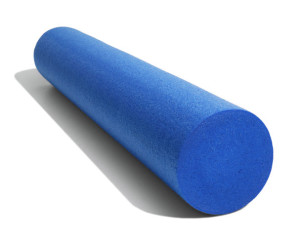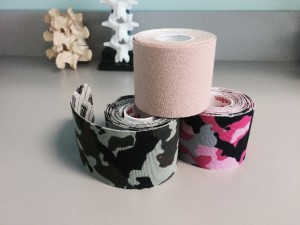When using a foam roller to decrease muscle pain/tightness, place it on the tender muscle. Roll the whole length of the muscle until you find a tender point. Spend 20-60 seconds on the tender point. You can either hold the foam roller over the tender point using your body weight or you can gentle slowly roll over the area. Spend no more than 5 minutes on a muscle. Be careful not to spend too long on one specific area because it can cause increased pain and bruising.
What Are The Benefits of Kinesiotape?
Kinesiotape is a 100% elastic tape with a breathable design, developed in 1970s and introduced clinically in mid-1990s. Kinesiotape has the ability to be stretched to certain levels of tension depending on the purpose of each particular taping technique. Kinesiotape is non-constrictive, providing support and stability while still allowing a muscle or joint to move through a normal range of motion. To learn about the benefits of Kinesiotape for an injury, check out below:
Free Event at Charm City Run Baltimore hosted by Harbor Physical Therapy
The Benefits of Exercise after 60
Come Join us! March 15th at 10:00 AM at Charm City Run Baltimore.
What is Dry Needling?
What is dry needling?
- Dry needling is a treatment involving a thin needle, used to target a painful trigger point. A trigger point is a painful muscle “knot” that can limit normalized movement and make every day tasks painful and difficult.
How does it work?
- The therapist feels for the trigger point and then inserts the needle. The needle helps to release the tightness, stimulate blood flow, and promote relaxation to the aggravated muscle.
Is it like acupuncture?
- Though both treatments use a thin needle, the dry needling treatment tends to be deeper. Humans have thick, large muscles and if needed the needle can go as deep as those large muscles and be quite uncomfortable. Where acupuncture treatment tends to be more skin level and cause less discomfort. There is no medicine used in the dry needling treatment, it is not an injection. The treatment can be uncomfortable and painful at times but is generally tolerated well. The therapist is always present and monitoring patient symptoms. The therapist will talk you through what to expect before deciding if this is an appropriate treatment for you.
How long does it last?
- Dry needling is one possible treatment option to be used in conjunction with massage, exercise, heat/ice to help manage pain. Results can vary from person to person and can range from very short term (hours-days) to more permanent effects. Generally, no more than 3-4 treatments will be done if no positive results are obtained.
How much does this cost?
- Dry needling treatment is covered by most health insurance plans.
Should I try dry needling?
- Dry needling can be helpful in treatment of conditions such as: myofascial pain, tension headaches, fibromyalgia, IT band syndrome, sciatica, piriformis syndrome, rotator cuff syndrome, and chronic neck and back pain. Talk to your therapist if you think this could be a helpful treatment for you. Do not consider dry needling if you have a fear of needles, are pregnant, immunocompromised or have systemic infections.
The Real Weight of Obesity: What It’s Really Doing to Your Body
Obesity is a complex health disorder in which excess weight gain puts an individual at high risk for osteoarthritis and several life-threatening medical conditions. Although the obesity epidemic is currently affecting millions of Americans across the country, each person’s battle with obesity begins right at home with personal lifestyle choices.
Contributors to obesity include:
- Diet including intake of high-calorie foods
- Physical Inactivity
- Genetics (to an extent)
- Some illnesses
- Lack of sleep
- Certain medication use (such as steroids)
Effects of obesity may include (but are not limited to):
- High blood pressure
- Osteoarthritis – breakdown of cartilage between bones
- Diabetes
- Difficulty sleeping and breathing problems
- Heart disease
- Cancer
- Stroke
- Depression and social isolation
- Gallbladder disease
- Increased healthcare-related costs
Step-by-step on how to Fight Obesity:
- Drink lots of water! Keep your body hydrated throughout the day.
- Eat right! Fill your diet with whole grains, fruits and vegetables, and lean proteins; avoid foods with processed sugar and high animal fat content.
- Get active! Even a daily 10-minute walk can help. Challenge yourself by taking the stairs instead of the elevator.
- Stay active! The Physical Activity Guidelines for America recommends at least 2.5 hours of moderate aerobic activity or 75 minutes of vigorous activity per week to stay heart healthy and to add 2 additional days of strength training.
- Stay motivated! Find friends or family to share your experience with. Weight loss is a marathon not a sprint, losing 1-2 pounds per week is a healthy pace.
**Remember!! Every pound lost is a success! Small amounts of weight loss have been shown to have substantial benefits including reducing knee and hip pain from arthritis, increasing blood flow through the body and heart, and improving overall quality of life!
Medicare 2016 Physical Therapy Cap Information
The physical therapy cap limit for 2016 is as follows:
1. The first cap is $1,960
2. The second cap is $3,700
After you reach the first cap, your physical therapist must convey medical necessity of continued physical therapy services in the medical documentation. As long as continued physical therapy is considered medically necessary by Medicare, further physical therapy treatment will be covered by Medicare. The physical therapy cap restarts in 2017.
If you have any questions, please contact Harbor Physical Therapy at 443-524-0442.
Thanksgiving Survival Tips for Injury Prevention
- When creating your Thanksgiving meal, take several sitting breaks. Your legs and back will need some rest during the hours of food preparation, cooking, and baking.
- Be careful when bending to get dishes into and out of the oven. Thanksgiving turkey and side dishes can be quite heavy. Use your legs to lift versus your back. Pull dishes as close to your body as possible before attempting to lift. This will help save your back!
- Split up the clean dishes into smaller piles before trying to lift them into kitchen cabinets. This will limit strain to your arms and shoulders versus trying to lift a large stack of plates.
Sit to Stand Exercise
Do you ever want to give your therapist a standing ovation, but are unable to? Well the sit to stand exercise is a good exercise to strengthen the muscles in the abdomen and thighs to help with this activity. With improved strength comes improved balance and overall function. Here’s the proper way to perform the exercise:
1. Sit in middle or toward front of chair with your knees bent and feet flat on floor.
2. Slightly lean forward with your head and shoulders, while simultaneously lifting you buttocks from the chair. Use your hands as little as possible (or not at all, if you can)
3. Keep your back straight as you come up, so that you feel your abdominal/low back muscles do the work.
4. Slowly sit back down.
5. Keep back and shoulders straight throughout exercise.
6. Repeat. A good number to shoot for would be 5-10 repetitions.
The goal is to be able to increase your reps and require less use of hands as you become stronger.

The Importance of your Physical Therapy Home Exercise Program
Not performing your home exercises while undergoing physical therapy and even after discharge from physical therapy is comparable to taking only half of a prescribed antibiotic. You will not get the maximum outcomes from your physical therapy. The goal of the home exercise program is to re-condition the body, restore function, and reduce/manage symptoms.
Exercising at home helps to condition the body between physical therapy sessions. If a person relies only on physical therapy sessions and does not perform a home exercise program, the body will not build improved function or retain muscle memory between sessions.
Common reasons for not performing the prescribed exercises are decreased home exercises include pain with exercises, lack of motivation due to perceived lack of improvements, unhappiness from the loss of function caused by the problem, and just being plain busy. If you fall under any of the above categories, talk to your physical therapist so a practical and tailored exercise program can be developed and followed that match your lifestyle.
How To Tell If You Are Properly Hydrated
Hydration isn’t just important during physical activity. Sitting in the sun on a hot or humid day can cause dehydration. Being thirsty isn’t the best indicator of your need to hydrate, as it means you are already dehydrated. A good rule of thumb to tell if you are properly hydrated is to pay attention to the color of your urine. Pale and clear urine means you’re well hydrated. Dark urine means drink more fluids. Drinking water is the best way to stay hydrated. Also, certain foods include a high percentage of water, such as fruits and vegetables.




